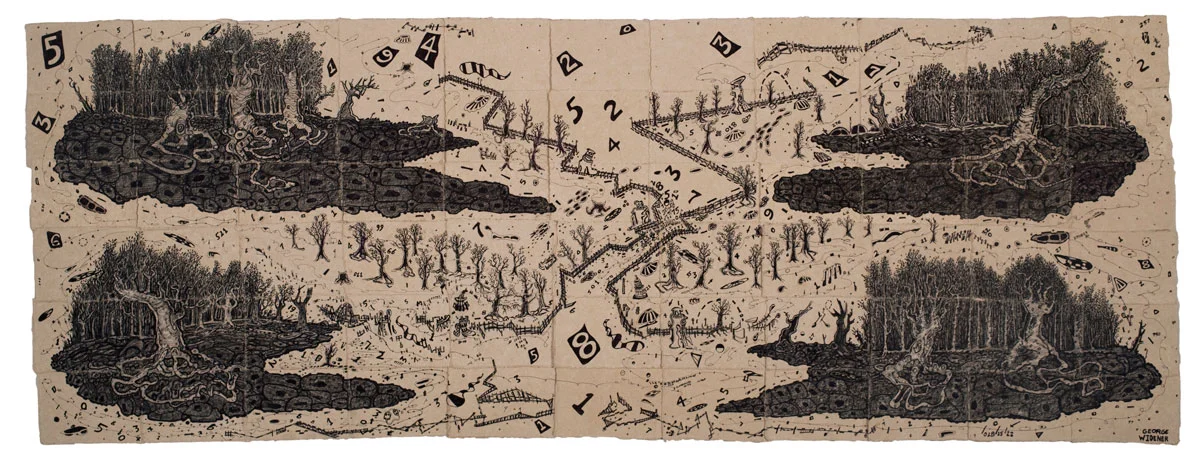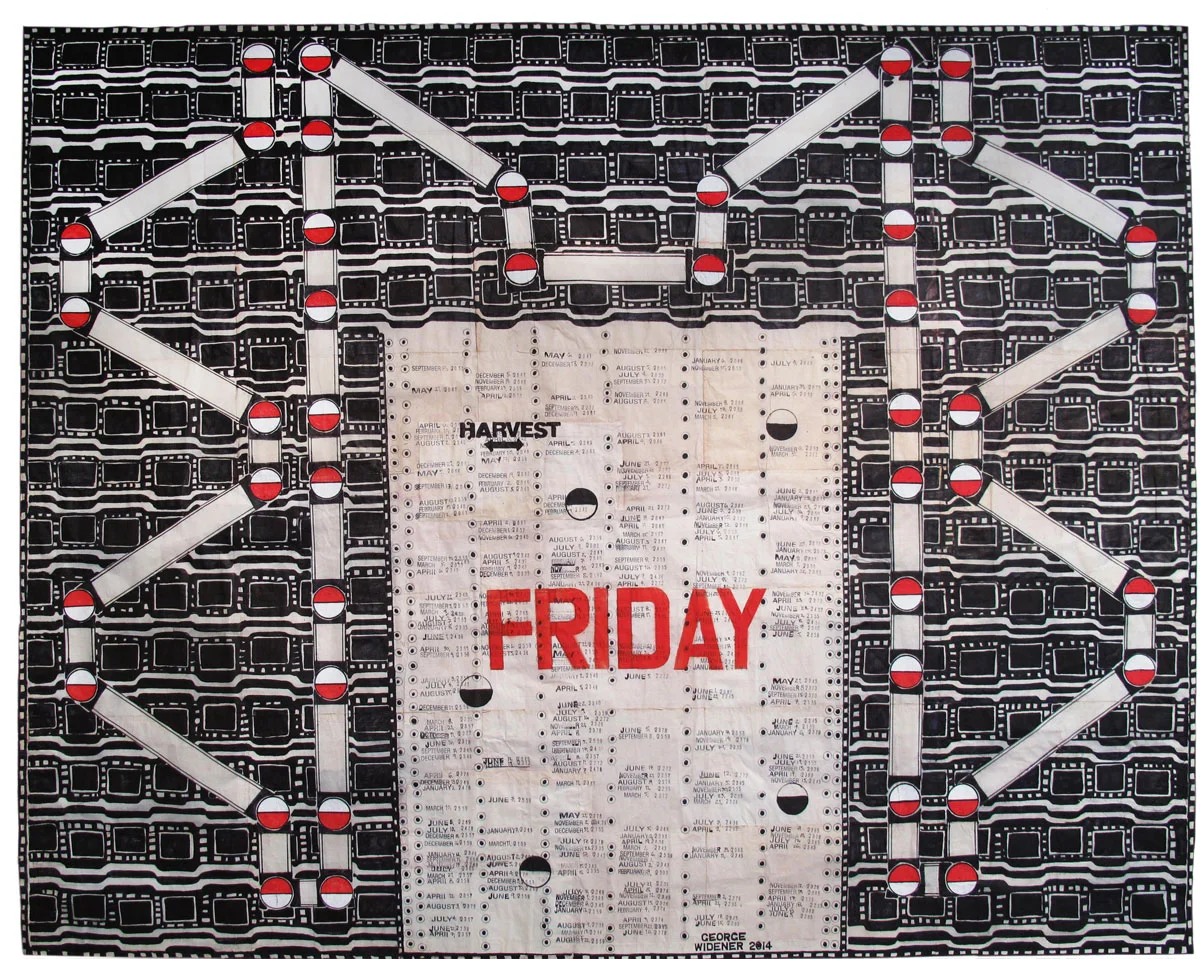
George Widener, “Asian Landscape,” (2010). Mixed media on paper. 14 x 42 inches. Courtesy Ricco/Maresca Gallery, New York.

George Widener, “Harvest,” (2014). Mixed media on paper. 47 1/2 x 59 1/2 inches. Courtesy Ricco/Maresca Gallery, New York.

Gregory Blackstock, Black Thesaurus handwritten list. Courtesy Greg Kucera Gallery, Seattle.

Gregory Blackstock, Historic Airliners handwritten list. Courtesy Greg Kucera Gallery, Seattle.
[](#)[](#)
Savants
Using Raymond? Hey Raymond, am I using you? Am I using you Raymond?
It is an exceptionally rare way of thinking that allows renowned artist—and autistic savant—George Widener to have a unique set of pattern recognition skills. During the Falklands War, the British flew Widener to England to advise their army (previously he helped analyze photos from the Stasi and the KGB for the U.S. government). It is a savant’s obsessively observant pair of eyes that made Stephen Wiltshire‛s photographic memory which allows him to faithfully reproduce a detailed city landscape after only a few seconds glance. It was the late Kim Peek’s encyclopedic memory of an incalculable number of facts that inspired the Academy Award-winning film _Rain Man._
Autistic savants commonly think in very organized and rigid processes, processes that lend themselves to being structured in list-like ways.
_to memorize a phone book_ _to instantaneously calculate the square root of 4,982_ _to identify which day of the week it was on January 4th 1042 B.C._ _to have perfect pitch, and to play a complete piece of music after hearing it only once_ _to have exceptional painting, sculpture and drawing skills_ _to read, write, and be able to translate 20 languages_
What better way to understand the psychology of the autistic savant than with a version of a detailed list; a timeline, compiled here in collaboration with Dr. Darold Treffert, who—when asked what the list of savant syndrome brain would look like—said, “The list would be extensive, exhaustive, and probably cramped.”
**1707** Jedediah Buxton is one of the world’s earliest mental calculators and savants.
**1783** The first account of savant syndrome in a scientific paper appears in the German psychology journal, _Gnothi Sauton_**.**
**1853** Four-year-old Thomas “Blind Tom” Wiggins—a blind child born to a mother sold at a slave auction—begins to show his extraordinary musical genius. He goes on to play at the White House at age 11, and later becomes the highest paid black performer in the world during his adult life. He is a favorite musician of Mark Twain.
**1833** James Pullen, known as “The Genius of Earlswood Asylum,” an extraordinary artist and wood craftsman, creates a meticulously made ship “_The Great Eastern”_ that wins first prize at the prestigious _Fisheries Exhibit_ in London. His work is collected by His Majesty King Edward, the then Prince of Wales, and the Queen.
**1887** Dr. J. Langdon Down describes 10 cases of spectacular musical, artistic, and mathematical skills in otherwise very cognitively impaired individuals. At this time the term “idiot” is an accepted, scientific term for a person with an IQ of less than 25. He combines that term with “savant” from a French term meaning “learned person” to acknowledge this juxtaposition of impairment with incredible talent, and coins the word “idiot savant.” At tis time, the term “idiot” does not have the pejorative and demeaning connotation that it does today.
**1914** Dr. Alfred Tredgold provides the first extended treatise on savants in a classic description of the condition in an entire chapter of his _Mental Deficiency_ textbook. In that book Tredgold gives extended descriptions of both Blind Tom and James Pullen.
**1923** Anecdotal accounts of various individual savants, mostly musical, appear as case reports in professional journals on a sporadic basis for the next half-century.
**1960s** Temple Grandin invents “The Squeeze Machine.”
**1964** A case is presented at the American Psychiatric Association Annual Meeting, of identical autistic twin brothers that had a calendar-calculating span of over 40,000 years backward and forward.
**1977** In a survey of institutionalized persons Dr. A. L. Hill finds the incidence of savant skills to be one in 2,000.
**1978** Dr. Bernard Rimland looks at the incidence of savant skills in 5,400 autistic children as reported to him by parents in a detailed questionnaire. Five hundred and thirty one children—approximately 10%—are found to have “special abilities.” It remains the largest single sample estimate reported and is still the generally accepted figure.
**1980** Dr. T. L. Brink reports a case of “acquired savant syndrome” in a previously neurotypical child following a gunshot wound to the head. In subsequent years other cases of acquired savant syndrome begin to appear.
**1980** On the _CBS Evening News_ Christmas Broadcast Walter Cronkite closes his program with a story about Leslie Lemke story. The story opens with these words: “This is a season that celebrates a miracle, and the story belongs to the season. It’s a story of a young man, a piano, and a miracle.” The story is also picked up by the shows _That’s Incredible!, Donahue, AM Chicago_ with Oprah Winfrey, _The Morning Show_ and many others.
**1983** _60 Minutes_ broadcasts a program called _Genius_ featuring; Alonzo, the sculptor; Leslie, the musician; and George, the calendar calculator. It is a program watched and remembered by millions. This same year the movie, _The Woman Who Willed a Miracle—_starring Cloris Leachman as May Lemke, Leslie Lemke’s foster mother—is released.
**1984** At a meeting for the Association of Retarded Citizens in Texas, Barry Morrow meets Kim Peek.
**1987** The BBC broadcasts a program called _The Foolish Wise Ones_ featuring a number of savants, including Stephen Wiltshire, a then 12-year-old artist who is now world famous for his meticulous drawings of cities after only a 45-minute helicopter ride.
**1988** The movie _Rain Man,_ starring Dustin Hoffman as Raymond Babbitt—an autistic savant—is released. Written by Barry Morrow—who is inspired by Kim Peek—the movie wins four Academy Awards, including Best Picture and makes ‘autistic savant’ a household term.
**1988** Dr. Darold Treffert suggests in a paper in the American Journal of Psychiatry that the archaic term “idiot savant” be officially dropped and the condition be called savant syndrome.
**1996** Two books by savants, _Thinking in Pictures_ by Temple Grandin in 1995 and _Born on a Blue Day_ by Daniel Tammet in 1997, capture a great deal of popular interest in savant syndrome.
**1997** A savant web site is established by the Wisconsin Medical Society (SavantSyndrome.com) and becomes a respected and popular clearinghouse for cases of savant syndrome worldwide.
